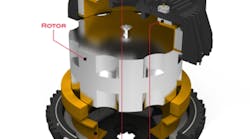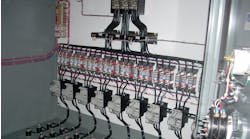According to a new UPS reliability assessment conducted by MTechnology, Inc., Active Power’s CleanSource 750HD UPS improves the reliability of mission-critical electrical systems compared to a legacy UPS. The key finding of the report was that CleanSource 750HD reduced risk of system failure by 21% vs. a double-conversion UPS with a single string of batteries in utility outages lasting longer than 10 seconds.
The full assessment and results of the study can be found in Active Power’s new whitepaper Mitigating Risk of UPS System Failure: Reliability Assessment of CleanSource HD Integrated Flywheel UPS versus Double-Conversion UPS with Batteries.
“With a dynamic electromechanical system like CleanSource 750HD, demand failures are highly unlikely,” said Steve Fairfax, president, MTechnology, Inc. “With the flywheel spinning, any changes affecting system health are detected and repairable prior to an outage occurring. Conversely, a battery-based system is an electrochemical process and exhibits non-detectable failures even with monitoring and routine maintenance.”
Commissioned by Active Power, the study examines the reliability of CleanSource 750HD vs. a double-conversion UPS with batteries and quantifies the likelihood of failure during three distinct scenarios – a long utility outage lasting more than 10 seconds; a short utility outage lasting less than 10 seconds; and a demand failure. For this study, a demand failure is a condition where the UPS fails when called upon to support a load during a utility outage.
The study also evaluates the reliability of CleanSource 750HD with a secondary energy source, which couples a flywheel with battery energy storage (Extended Runtime option) versus a legacy UPS.
Key findings from the independent study include:
- CleanSource 750HD reduced the risk of failure by more than 21% during long outages versus the modeled double-conversion UPS with batteries, 6.73% versus 8.58%, respectively.
- For short outages, CleanSource 750HD had an 80% lower probability of failure versus a double-conversion UPS with batteries, 0.50% versus 2.05%, respectively.
- The likelihood CleanSource 750HD would not support the load when called upon (demand failure) was dramatically lower compared to a double-conversion UPS with batteries, 0.000067% versus 2.05%, respectively.
- The addition of the Extended Runtime option to CleanSource 750HD further improved reliability over legacy UPS. During long outages, CleanSource 750HD with Extended Runtime reduced the risk of failure by more than 23% versus a double-conversion UPS with batteries (6.60% versus 8.58%, respectively). During short outages, the system reduced the risk of failure by 85% (0.36% versus 2.46%, respectively). The improved reliability is due to the presence of two distinct energy sources (flywheel and batteries).
- The most likely failure mode of a double-conversion UPS with batteries is due to undetected battery failures. Non-detectable and detectable battery failures account for more than 83% of all double-conversion UPS failures.




